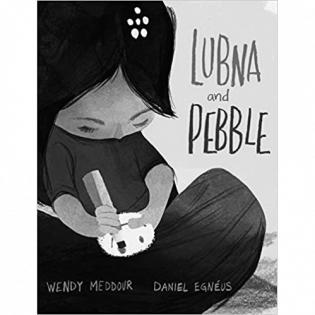Lubna and Pebble Literature Guide
In this book, Lubna arrives as a refugee in a tent city after escaping an unknown place in the Middle East with her father. She faces confusion and loneliness while missing her family. Lubna finds comfort in talking to a pebble until she meets another friend. Her generosity when she finds a home and leaves her new friend is a touching example of the power of empathy and kindness.
Before Reading
Ask: When you are alone and lonely, what do you do to comfort yourself? Maybe you sing to yourself, play with a toy, or read a book. Lubna found comfort with the only object she had.
Show: Look at the cover of the book. How would you describe Lubna just from the cover image?
Connect: A refugee is someone who must leave their home because of danger and come to a place of safety. What feelings might arise to wake up in a tent city in a strange place after leaving your home that is no longer safe?
During Reading
Ask: What did Lubna do to make the pebble a comfort item?
Show: Look at the picture of Lubna in her father's arms. Why do you think the author called them "salty arms"?
Connect: Have you ever found a friend in an unexpected place? What brought you together? Think about what connects you to different people.
After Reading
Ask: What did Lubna do that was difficult for her but helped Amir? Define empathy as putting oneself in another's place to understand their feelings. How did empathy help Lubna figure out how to help Amir?
Show: Look at the page when she is giving Amir her pebble. Describe her kind acts. How did her actions help Amir?
Connect: Being generous can help the giver and the receiver of a kind act. List some ways kindness can help the person who is generous.
Activities
- Find a stone or pebble that has a pleasing shape and texture. Draw a design on it and give it to someone as a gift to brighten their day.
- Read about the difference between refugees and immigrants. This toolkit has information and ideas for service projects to help refugees.
- This Doodle Stones service idea spreads messages of kindness around the neighborhood. Alternatively, this Neighborhood Ladybug Hunt helps young people organize a hunt for painted stones.
- Talk with one other person and practice the skill of empathy. Ask them to tell about a time they had a strong feeling, then listen carefully. Try to feel the same feeling. Then tell them what you heard them say and how it made you feel. Use this video clip to help define empathy.
